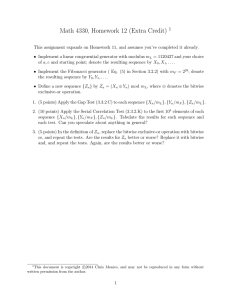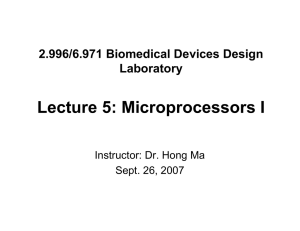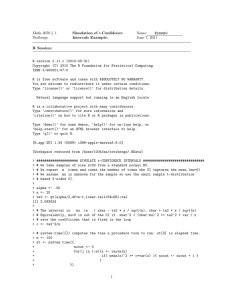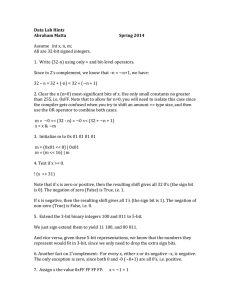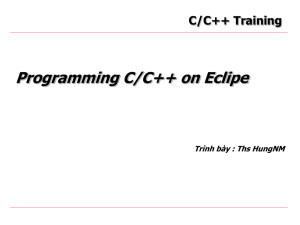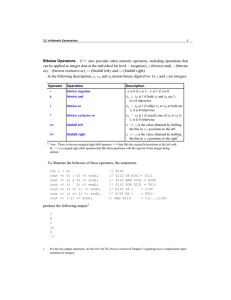Introduction to Logic, Numbers, C and the MSP430
advertisement
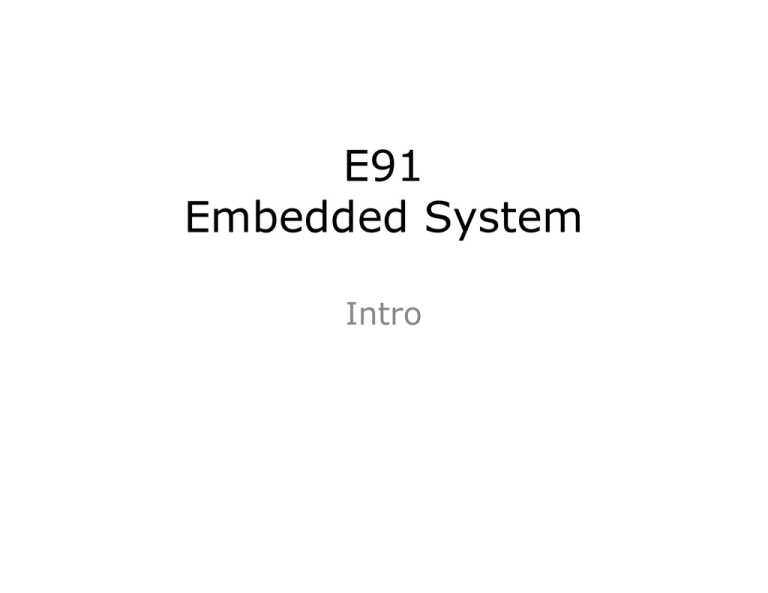
E91
Embedded System
Intro
Why embedded systems?
• Big bang
bang-for-the-buck
for the buck by adding
some intelligence to systems.
• Embedded Systems are ubiquitous.
ubiquitous
• Embedded Systems more common
as prices
i
drop,
d
and
d power decreases.
d
Which Embedded System?
• We will use Texas Instruments MSP-430
+ very popular (#2 next to microchip)
+ 16 bits (instead of 8)
+ low
l
power
+ clean architecture
+ low cost (free) development tools
- relatively low speed/capacity (i.e., no video
or fancy audio)
- low level tools (compared to Stamp,
Stamp
Arduino…)
- 16 bits (instead of 32)
Course overview
• Mix of hardware and software
• Mostly C, some assembly
• Lots of information, less conceptual than many
courses.
• Two hardware kits, EZ430 and the 430
Experimenter’s Board
• About 2 hours of lecture per week.
• More hours in lab – writeups will be short.
short
• In lab you will need to become familiar with a
broad set of documentation. I will try to keep a
complete list on website.
website Let me know if you find
good documents I have not listed.
• You will need to be more self-reliant than in many
courses (though I am always ready to help).
help)
• Maybe some assignments.
Policy on working together :
Policy on working together :
• Lab groups should be 2 (preferably) or 3 students.
• We expect labs to be done as a group with your lab We expect labs to be done as a group with your lab
partners. You may discuss your lab with other g p,
groups, but you may not copy anything from their y
y
py y
g
reports. Each group will submit a single report (with all members of the group listed).
Today
• Brief overview of
o logic
o numbers
oC
o MSP430 digital I/O
Today’s lecture will be very densely packed so you can start on the lab. We will come back and repeat some of the material in more depth as needed.
Brief Review of Logic
• In this class we will deal with logical
circuits (i.e., inputs are either true
((logical
g
1,, for us this is 3.3V)) or false
(logical 0, for us this is 0V). In class
you will learn why this is useful, for
now, acceptt it.
it
• To deal with these signal levels we
d
develop
l
a special
i l form
f
off
mathematics, Boolean algebra.
Boolean Operators
• Operators:
o AND : C=A·B
(Read as C equals A and B).
Input A
Input A
Input B
Output C
Output C
0
0
0
0
1
0
1
0
0
1
1
1
“Truth Table”
Sometimes the “∙” is dropped: C=AB
logic gate images adapted from: http://www.ee.surrey.ac.uk/Projects/Labview/gatesfunc/index.html
More logic…
A
B
D
0
0
0
0
1
1
1
0
1
1
1
1
A
F
0
1
1
0
A
B
H
0
0
1
0
1
0
1
0
0
1
1
0
… and even more.
eXclusive OR
Note:
XOR with 1 inverts bit, O ih i
bi
XOR with 0 passes bit.
A
B
G
0
0
1
0
1
1
1
0
1
1
1
0
A
B
J
0
0
0
0
1
1
1
0
1
1
1
0
Number Systems
Binary: 000011012 =
1·23
1·22
0·21
+
+
8 + 4 + 1 = 13
+
1·20
Decimal
Binary
Hex
0
0000
0
1
0001
1
2
0010
2
3
0011
3
4
0100
4
5
0101
5
6
0110
6
7
0111
7
8
1000
8
9
1001
9
10
1010
A
11
1011
B
12
1100
C
13
1101
D
14
1110
E
15
1111
F
=
Hex: 001010102 = 2A16 = 0x2A = 2·161 + 10·160 =
32 + 10 = 42
(check 1·25 + 1·23 + 2·21 = 32 + 8 + 2 = 42)
8 bits = 1 byte
0000 00002 → 1111 11112
0x00 → 0xff
0 → 28-1=255 (or -128 → 127
(-(27) → 27-1)))
16 bits
bit = 2 bytes
b t
= 1 word
d
0000 0000 0000 00002 → 1111 1111 1111 11112
0x0000 → 0xffff
0 → 216-1=65535
4 bits = 1 nybble
(or -32768 → 32767 (-(215) → 215-1)))
(0 → 24-1=15)
A simple C program
#include
<msp430x20x3.h>
Constants associated with our chip
Every program needs a “main” routine (between braces)
Declare “i” as volatile so compiler doesn’t optimize it out of existence (or turn optimizations off).
(
p
)
All variables must be declare before they are used.
void
i main(void)
i
i
{
volatile int i;
WDTCTL = WDTPW + WDTHOLD; // Stop watchdog timer
P1DIR |= 0x01;
// Set P1.0 to output direction
“1” i l
“1” is always true, so loop forever.
t
l
f
while (1) { //Do this forever
P1OUT = P1OUT | 0x01;
// Set P1.0 with “or”, |
for (i=0; i<0x5000; i++) {}
// Delay
P1OUT
1O
= P1OUT
1O
& ~0x01;
0 01
// Cl
Clear P1.0
1 0
for (i=0; i<0x5000; i++) {}
// Delay
}
}
Set bit 0 high (connected to LED)
Loop to waste time
Don’t worry about for now.
Set bit 0 low (LED turns off)
Loop to waste time
Set bit 0 in “P1DIR”
Set bit 0 in P1DIR ‐ this makes it an output (next page).
this makes it an output (next page)
Comments start with “//” and go to end of line.
Also note that every statement ends with “;” or “}”
A typical I/O pin
Analog switch
Inverted input
SD16AE=0, by default
P1REN=0, by default
Electronically controlled digital switch
2‐1 Mux (multiplexer)
Tri‐State Output
P1SEL=0, by default
Schmitt trigger (hysteresis)
gg ( y
)
Transparent latch
Effect of P1DIR
0
0
0, switch is open
P1DIR=0
P1DIR=1
P1DIR 0
1
0
Vin
P1OUT
P1OUT
P1OUT
Hi‐Z
0
1
0
Hi‐Z
Vin
P1OUT
0
Latch is disabled
Variant 1 (more readable)
#include <msp430x20x3.h>
#define LED
0x01
Give constants meaningful names
Give constants meaningful names.
void main(void) {
volatile int i;
WDTCTL = WDTPW + WDTHOLD; // Stop watchdog timer
P1DIR
1
|
|= LED;
// Set P1.0
1 0 (LED
(
bi
bit)
) to output
while (1) { //Do this forever
P1OUT |= LED;
f
for
(i 0 i<0x5000;
(i=0;
i 0 5000 i++)
i ) {}
P1OUT &= ~0x01;
for (i=0; i<0x5000; i++) {}
}
//
//
//
//
Turn on LED
Delay
l
Turn off LED
Delay
}
Equivalent to: P1OUT
i l
= P1OUT | LED;
Variant 2 (macros)
#include <msp430x20x3.h>
#define LED
0x01
#
#define
i
SETBIT(p,b) (p |= (b))
#define CLRBIT(p,b) (p &= ~(b))
Use Macros sparingly, but they can make code look much cleaner (see below)
void main(void) {
volatile
l il int
i
i
i;
WDTCTL = WDTPW + WDTHOLD; // Stop watchdog timer
P1DIR |= LED;
// Set P1.0 to output direction
while
hil (1) { //Do
//
this
hi f
forever
SETBIT(P1OUT,LED);
for (i=0; i<0x5000; i++) {}
CLRBIT(P1OUT,LED);
f
for
(i
(i=0;
0 i<0x5000;
i 0 5000 i++)
i ) {}
}
Expands to: Expands
to: (P1OUT |=
| (0x01))
Note “;” must be added. //
//
//
//
Set P1.0
Delay
Clear P1.0
D
Delay
l
}
Variant 3 (shorter)
#include <msp430x20x3.h>
#define LED
0x01
#
#define
i
SETBIT(p,b) (p |= (b))
#define CLRBIT(p,b) (p &= ~(b))
#define TGLBIT(p,b) (p ^= (b))
void
id main(void)
i ( id) {
New macro to toggle (xor) bit
volatile int i;
WDTCTL = WDTPW + WDTHOLD; // Stop watchdog timer
P1DIR |= 0x01;
// Set P1.0 to output direction
while (1) { //Do this forever
TGLBIT(P1OUT,LED);
for (i=0; i<0x5000; i++) {}
}
}
// Toggle LED
// Delay
Loop is half as long as before
C Data Types
(that we will use)
Type
Size
(bits)
Representation
Minimum
Maximum
char, signed char
8
ASCII
‐128 +127
unsigned char, bool
8
ASCII
0
255
int, signed int
16
2s complement ‐32 768 32 767
unsigned int
16
Binary
0
65 535
long signed long
long, signed long
32
2s complement
2s complement
‐2 147 483 648
2 147 483 648
2 147 483 647
2 147 483 647
unsigned long
32
Binary
0
4 294 967 295
enum
16
2s complement
‐32 768 32 767
float
32
IEEE 32‐bit
±1.175 495e‐38
±3.40 282 35e+38
C Operators
(Arithmetic)
Arithmetic Operator name
Syntax
Basic assignment
a=b
Addition
a+b
Subtraction
a‐b
Unary plus
+a
Unary minus (additive inverse)
‐a
Multiplication
a*b
Division
a/b
Modulo ((remainder))
a%b
Increment
Decrement
Prefix
++a
Suffix
a++
Prefix
‐‐a
Suffix
a‐‐
More C Operators
(Relational, Logical, Bitwise and Compound)
Relational Operator name
Equal to
Not equal to
Greater than
Less than
Greater than or equal to
Less than or equal to
Less than or equal to
Bitwise Operator name
Bitwise NOT
Bitwise
NOT
Bitwise AND
Bitwise OR
Bitwise XOR
Bitwise left shift
Bitwise right shift
Syntax
a ==b
a !=b
a>b
a<b
a >=b
a <=b
Logical Operator name
Logical negation (NOT)
Logical AND
Logical AND
Logical OR
Compound Operator name
Syntax
!a
a &&b
a ||b
Syntax
Addition assignment
a += b
Syntax
Subtraction assignment
a ‐= b
~aa
a&b
a|b
a^b
a <<b
a >>b
Multiplication assignment
Multiplication assignment
a *== b
Division assignment
a /= b
Modulo assignment
a %= b
Bitwise AND assignment
a &= b
Bitwise OR assignment
a |= b
Bitwise XOR assignment
a ^= b
Bitwise left shift assignment
a <<=b
Bitwise right shift assignment
a >>=b
More C
Statements
• a simple statement is a single statement that ends in a “;”
• a compound statement is several statements inside braces:
{
simple statement;
…
simple statement;
}
Indentingg
There are no rules about indenting code, but if you don’t adopt a standard style, your code becomes unreadable.
Even more C
Array definition
int a [100];
//Array elements are a[0] to a[99].
if…then
if (<expression>)
<statement>
<statement> may be a compound statement.
if then else
if…then…else
if (<expression>)
<statement1>
else
<statement2>
Don’t use a[100]!
Yet more C
Iteration (do…while while… for…)
(
)
do
<statement>
while ( <expression> );
while ( <expression> )
<statement>
for ( <expression>
p
; <expression>
p
; <expression>
p
)
<statement>
Recall: for (i=0; i<0x5000; i++) {}
// Delay
for (e1; e2; e3)
s;
is equivalent to
e1;
while
hil (
(e2)
2) {
s;
e3;
}
The break statement is used to end a for loop, while loop, do loop, or switch statement. Control passes to the statement following the terminated statement.
Again with the C
switch (one choice of many)
i h(
h i
f
)
switch (<expression>) {
case <label1> :
<statements 1>
case <label2> :
<statements 2>
break;
default :
<statements 3>
}
• <expression> is compared against the label, and execution of the associated statements occur (i e if <expression> is equal to <label1> <statements 1> are
statements occur (i.e., if <expression> is equal to <label1>, <statements 1> are exectuted.
• No two of the case constants may have the same value. • There may be at most one
y
default label.
• If none of the case labels are equal to the expression in the parentheses following switch, control passes to the default label, or if there is no default label, execution resumes just beyond the entire construct. • Switch statements can "fall through", that is, when one case section has completed its execution, statements will continue to be executed downward until a break; statement is encountered. This is usually not wanted, so be careful
Material taken from:
•
•
•
•
•
•
http://en.wikipedia.org/wiki/C_syntax
htt //
http://en.wikipedia.org/wiki/Indent_style
iki di
/ iki/I d t t l
http://en.wikipedia.org/wiki/Operators_in_C_and_C++
http://focus.ti.com/lit/ug/slau144e/slau144e.pdf
http://focus.ti.com/lit/ds/slas491e/slas491e.pdf
http://focus.ti.com/lit/ug/slau132c/slau132c.pdf
